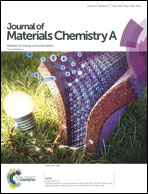A robust network binder with dual functions of Cu2+ ions as ionic crosslinking and chemical binding agents for highly stable Li–S batteries†
Abstract
Binders play a crucial role in improving the electrochemical performance of batteries. The major challenges associated with the sulfur cathode in lithium-sulfur (Li–S) batteries are up to 76% volume change during cycling from sulfur (S) to lithium sulfide (Li2S) and the shuttle effect of polysulfide anions, resulting in poor cycling performance. Herein, we design a network binder through the crosslinking effect of sodium alginate (SA) and Cu2+ ions (named the SA–Cu binder), in which Cu2+ ions work not only as an ionic crosslinking agent for a robust network structure, but also as a chemical binding agent for polysulfide anions. The robust network binder buffers large volume variations during cycling, while electropositive Cu2+ ions immobilize polysulfide anions through strong chemical binding. The resulting sulfur electrode delivers a capacity of 925 mA h g−1 after 100 cycles at 0.2C, which is much higher than those of sulfur electrodes with only SA and PVDF binders. Due to the robust mechanical properties of the SA–Cu binder, a high-loading and crack-free sulfur electrode, i.e., a sulfur loading up to 8.05 mg cm−2, is also achieved and delivers a high areal capacity up to 9.5 mA h cm−2. This study paves a new way to immobilize polysulfide anions using the dual functions of Cu2+ ions as both the ionic crosslinking and chemical binding agents, which could open up a new direction for advanced binders for Li–S batteries in the near future.



 Please wait while we load your content...
Please wait while we load your content...